Back in 1918, two different flags emerged in the young Ukrainian state. The first was yellow-blue, and the second of its inverted version - blue-yellow. After the overthrow of the Central Rada, the Russian monarchist Skoropadsky legalized an inverted flag as a symbol of his own struggle.
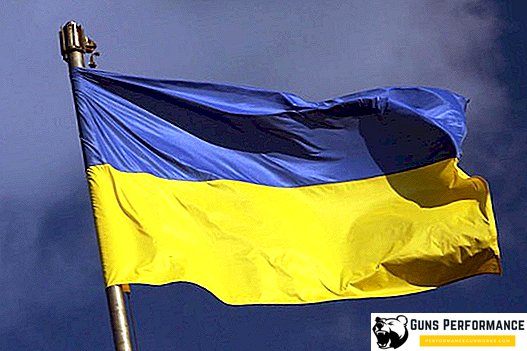
That was the state flag of Ukraine - two strips of blue and yellow.
National flag of Ukraine: mystical symbolism
In general, everything that has a golden, yellow color can symbolize the Creator, God the Father, or something higher, spiritual. The blue color speaks about everything earthly, as well as the freedom of choice that the Creator endowed his Children with the hope that there would be no abuse on their part.
The interpretation of the blue of the sky and the golden spikes, which we have adopted today, is not simple primitivism, it is yet another attempt to triumph global evil.
What does the flag of Ukraine mean
Some experts believe that in reality, the color of the Ukrainian flag from time immemorial symbolized two of the most important natural elements and human existence - fire (yellow) and water (blue). Thus, a completely logical picture emerges. Only the combination of "yellow - from above, blue - from below" can reflect the eternal symmetries, namely the influence of the divine harmonies of these elements in their places of stay. However, if they are placed from head to foot, it will symbolize the violation of the world order, a cataclysm in which fire is extinguished by water.

Gold-blue coming Tripolytsy
For a long time, various nations in the days of battles used a certain symbolism, which was supposed to signify the whereabouts of the warriors, as well as to raise their fighting spirit. For the most part, these were three- quadrilateral pieces of cloth attached to spears. At the time of Kievan Rus, the ancient Ukrainian flags originally depicted Christian saints. Later, permanent emblems of various territories began to appear, which became the basis for the modern national symbols that had been formed.
Actually such a gold-blue symbolism was brought once by the Tripoli people in the era of large migrations of peoples. One part of the immigrants left the Northern Black Sea region five thousand years ago, and settled in ancient India, where symbolism has survived to the present in its original form. This state is literally all decorated with such color combinations. However, it is nowhere to be seen that blue dominates over yellow.
Banners of the times of Kievan Rus
In the hours of ancient Russia, one of the main attributes in symbolism, indicating the princely power, were banners. Then it was the banners under which the warriors participated in the battles. At the same time, the banners were symbols of territorial associations. In the ancient chronicles there is evidence that in the times of Vladimir Russia the flags had triangular wedge-shaped forms with images of saints or princely symbols.
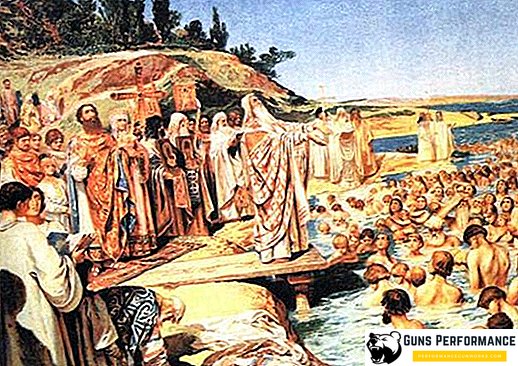
Mostly the banners were painted red, so that they could be well recognized during the periods of battle. Sometimes white, blue, yellow, green colors could be used. It is desirable to remember that red is still considered to be a fairly popular shade in the color heraldic palette. And this was especially true of the Western and Eastern Slavs living in the territories of Poland, Belarus and Russia.
National flag of Ukraine in the XIII-XVI centuries
At the junction of the XIII-XIV centuries, banners of quadrangular shapes appeared at the free ends of copies. In addition, during this period, banners began to be made vigorously, in which several colors were simultaneously combined. In the XIII-XIV centuries, the history of Kievan Rus was characterized by feudal fragmentation. In those days, the princes had their banners, which were always different from the rest.
Already by the 14th century, Left-Bank Ukraine in a large part was attached to the Grand Duchy of Lithuania. At that time, the Galician lands, along with Volyn, found themselves under the Polish protectorate, which greatly influenced the heraldry in these native Ukrainian territories. Thus, in the symbolism of Central Ukraine, it is possible that it was under the influence of the Poles that white and red colors began to appear. Whereas yellow-blue colors began to dominate in the Ukrainian flags of the western regions. Lviv, Transcarpathian and Podolsk heraldic symbols began to be painted with these basic colors.
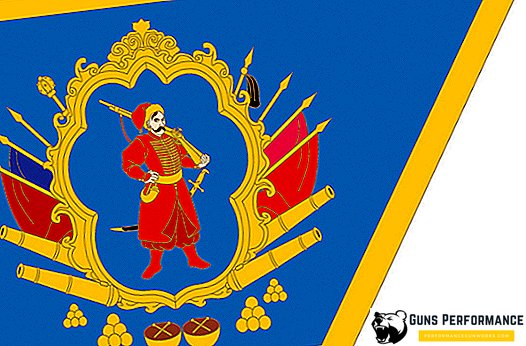
Banners and symbolism of the hetman period
Historically, the Ukrainian flag may have more than one century, if not millennia. Thus, traditions influenced the formation of modern national symbolism of the state. In the Ukrainian Cossacks, the main color was crimson. Actually, under him, Bogdan Khmelnitsky led the national liberation movement. In addition, the crimson was mainly in the Nezhinsky and Chernigov regiments. Frequently, the hierarchy patron of the Zaporozhian Army was depicted on the Hetman’s banner. In addition, on the crimson banners there could be inclusions of yellow, blue and green colors, as well as sketches of the sun, stars, animals.
The history of the Ukrainian flag in the XVIII-XX centuries.
Ukrainian heraldic symbolism began to fill with blue and yellow colors in the XVIII century. Their combinations are sought in the banners of the Kiev and Chernigov regiments. In 1771, the Poltava regiment acquired for itself a new banner with the image of a yellow cross on a blue cloth, and in 1848, the Head Ruska Rada proclaimed the national coat of arms of the ancient princely symbol of Romanovich. It depicted a golden lion leaning on a rock in a turquoise setting.
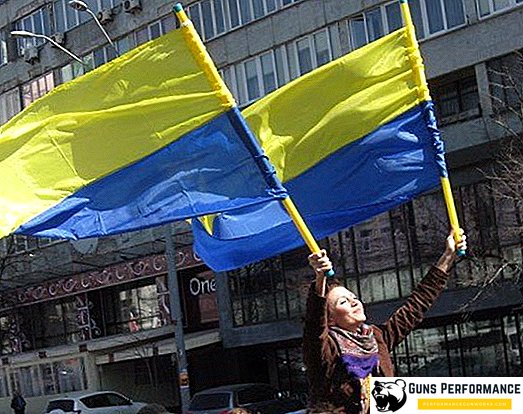
The second half of the XIX century was marked by the gradual establishment of a junction of yellow and blue stripes on rectangular panels of Ukrainian flags. After that, in 1914, during the celebration of the next anniversary of Kobzar, the combination of these colors could only mean one thing - national character traits in the demonstrations. It is worth knowing that at these times the upper band in the Ukrainian flag was exactly yellow, and the lower - blue. And since that time, the new flag of Ukraine has been universally called “yellow-blakitnim”. In the turbulent times of 1917, the Ukrainian People’s Republic was proclaimed. Its government, the Central Council, proclaimed the colors inherent in the national flag, all the same yellow and blue.
Ratification of the blue and yellow flag
In 1918, after the establishment of power by Hetman P. Skoropadsky, there was a change in the national flag. Actually, it was then that the substitution of the yellow-blue flag with the blue-yellow one occurred. The ratification of this color scheme, as national, was witnessed through the normative and constitutional acts of the then-Directory. The same has done the West Ukrainian People's Republic.
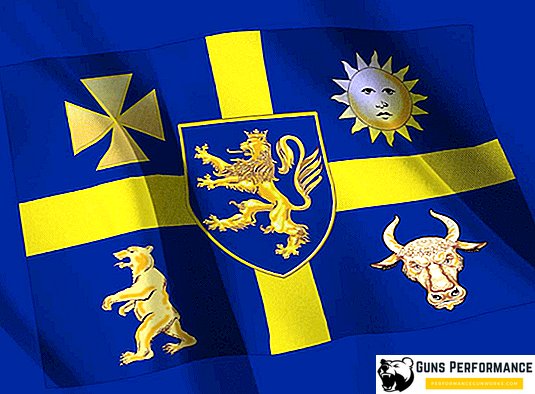
The flags of the Ukrainian origin of the Soviet era radically differed from the previous ones, national ones. Originally it was a red panel with an inscription in gold: "UCRR". In the postwar years, socialist symbolism changed a bit. Thus, the flag of the Ukrainian Soviet Socialist Republic united in itself two colors with two stripes: the top one - red, the bottom one - blue. And in the upper part of the cloth a sickle with a five-pointed star was depicted.
In 1990, for the first time after a long interval, the blue and yellow Ukrainian flag reappeared on the Town Hall in Striyu. Photos and the latest news about this incredible event of that time in an instant, spread throughout the Ukrainian territory. On a warm September afternoon in 1991, the national symbol proudly towered above the premises of the Verkhovna Rada. The following year, on January 28, 1992, the blue and yellow flag was destined to receive state status. Thus, every year, on the 23rd of August, before the celebration of the Independence Day of Ukraine itself, the Flag Day of Ukraine is celebrated in the country.
National flag of Ukraine: the true meaning of flowers
In the heraldic laws, the yellow color symbolizes gold, fire, the Sun and cannot be below, therefore the current color combination on the Ukrainian flag seems unnatural and dangerous. For example, the ancient emblem of creating the world out of chaos, conveys precisely these colors. When earthly and passive principles dominate the celestial and active, then any state will be programmed to fail in advance.

Even according to Feng Shui, to place blue (will) over yellow (wisdom) means to activate decay or progressive degradation, unhappiness and disorder. If you do everything right, then the harmony of heaven and earth, yin and yang, strength and flexibility, will be the forerunner of development, well-being and happiness.












